Jabra Drive Speakerphone Review
In the blog on Geektimes we do reviews of the most different devices which are on sale in our shops - from digital microscopes and LEGO to transformers laptops and ... and today we will talk about such piece as a automobile speakerphone.
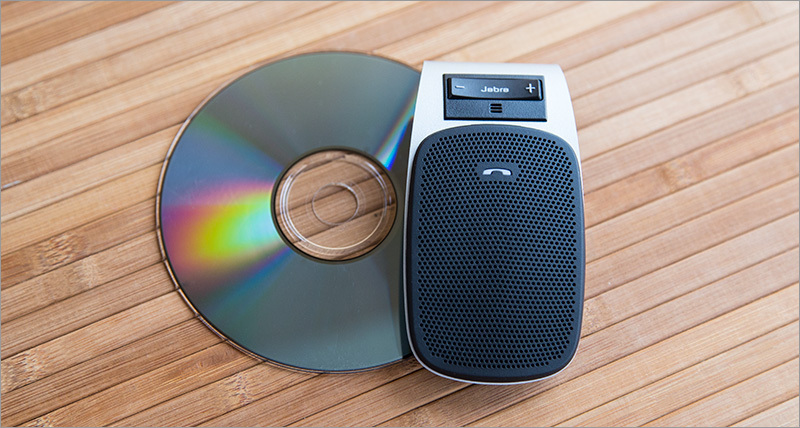
If your car is not equipped with a handsfree system, then such a device will add +1 to your safety while driving - I think this is much more necessary thing than, for example, a wireless speaker with the same principle of operation.
The device is sold in traditional (for Jabra products) black and yellow packaging. The device itself is located in the upper part of the package (you can easily get it, for example, for checking in the store), and all the other parts are under it.
')

The package is modest - in addition to the adapter-plug for power supply from the car network (12-24V at the input, 5V and 750mA at the output) with a USB connector:
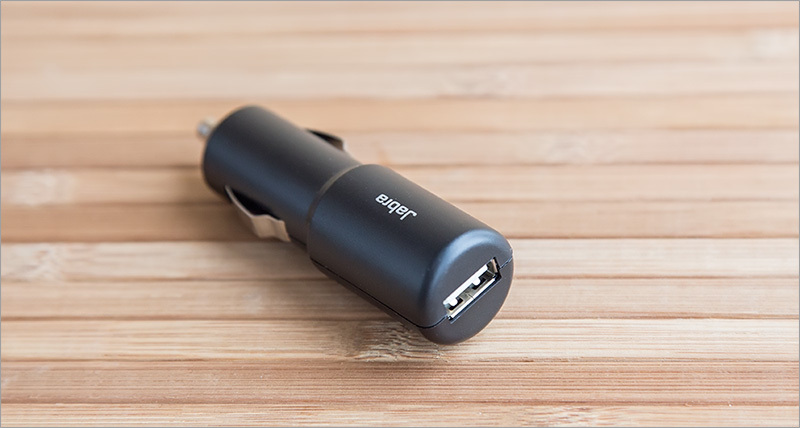
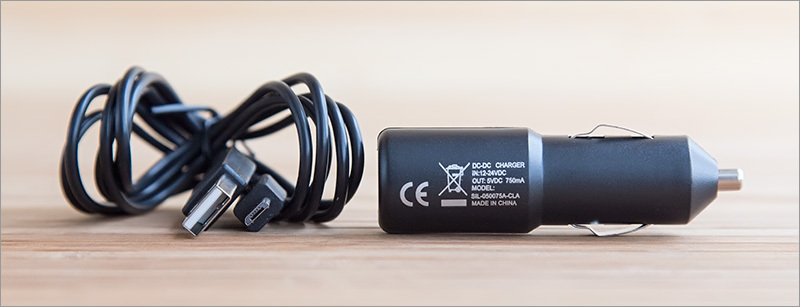
... there is only a meter-long USB-microUSB wire (for charging the device) and instructions in several languages (including Russian):
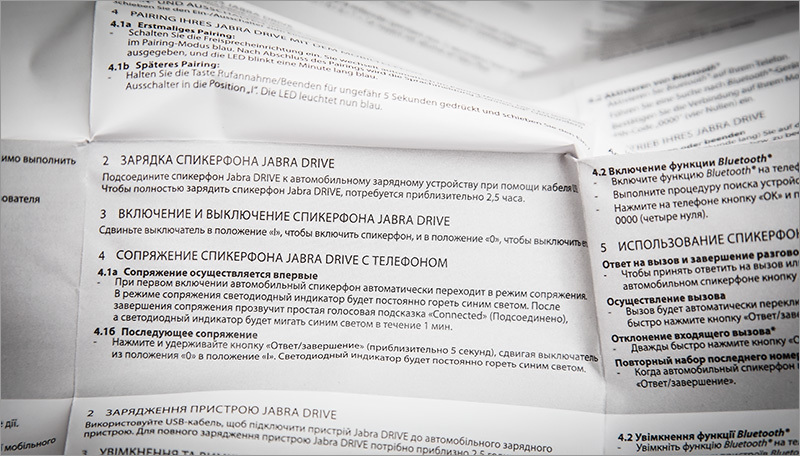
On the one hand, the set has everything for “sat down and went,” on the other hand, I wanted to see at least a rag cover - surely many people will sometimes remove the device in the glove compartment.
The device is quite large (104x56x18mm with a weight of 100g), it is pleasant in the hand, but its form makes it unambiguously clear that the manufacturer implies a “hook” fastening. Well, since this Jabra is called Drive, then it is meant to be mounted in the car, namely, on the sun visor. However, nothing interferes with fastening it somewhere on the desktop or on a backpack during a hike - anything can happen.
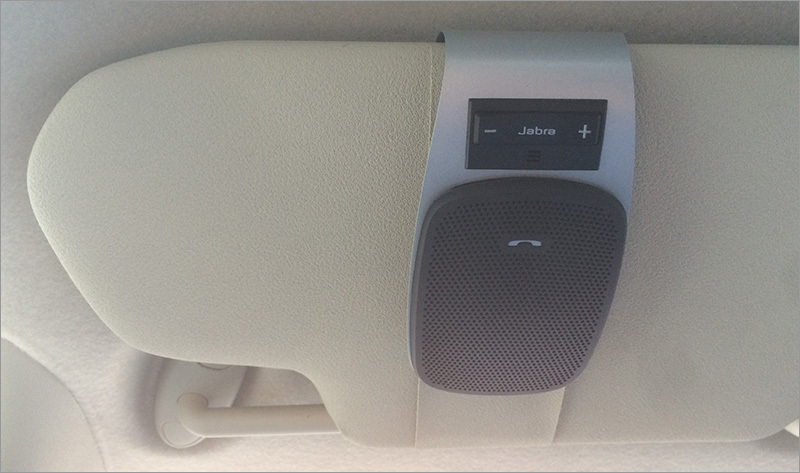

The mount itself is a bent sheet of metal on which the speaker is mounted with the rest of the electronics. The design is universal (there is a margin for deformation - in case you have a lot of pieces of paper under the visor) and reliable - it should not break from assembly / disassembly. From the street, the device is completely unnoticed.
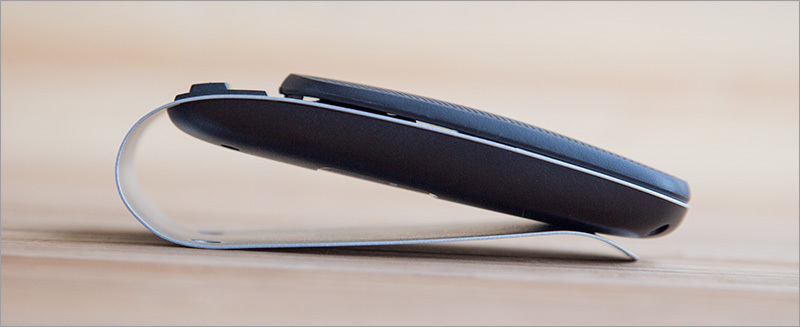
The main part of the functional side is occupied by the speaker, which is located behind the black (there is a white version) cover-grid. At first it seemed to me that a giant gap was conveniently located between the speaker and the mount, but it turned out that this was the place for the button to move - the fact is that the speaker is also a button at the same time (for example, receiving a call). It also has a status LED in the form of a tube, which is lit in different colors depending on the mode of operation. It's great - with such dimensions it is difficult to miss even at speed.

Just above is a microphone and rocker for volume control, also quite large. Their main drawback is that to adjust the volume you need not to hold, and repeatedly press - on the road this is not the most convenient scenario. But this is not a problem - most likely you will once set the volume level that is convenient for you and forget about these buttons (well, or you will make it louder / quieter once a month.

Another button (to turn on the device) is located on the side - it does not accidentally touch it. From the connectors - only microUSB for recharging the built-in battery.

I can’t say that I’m straight from the look of this device, but at the same time there’s nothing in it that I don’t like; workmanship and assembly at a high level.
A question for connoisseurs: why two holes on the device mount? Smiled when I found the answer.
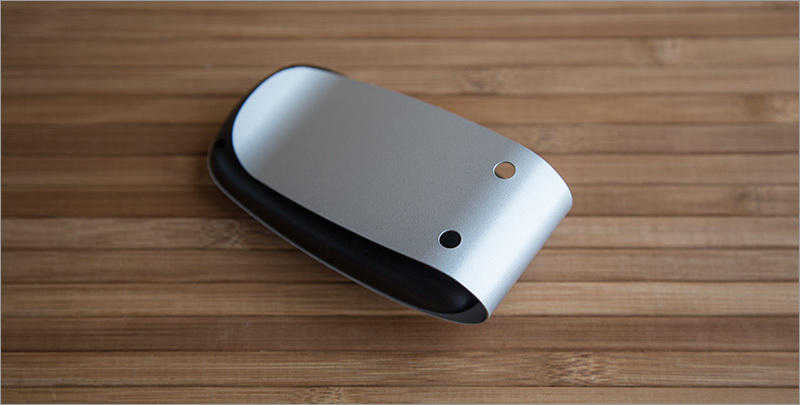
When first turned on, the device will automatically suggest pairing with the phone - the pairing algorithm is no different from other bluetooth devices. NFC is not here, so the speakerphone won't be able to pick up the speakerphone, and the model was developed back in 2011, when they didn't even really talk about NFC. But it is worth paying tribute that after almost 4 years, the model remains relevant and competitive.
Talking on the “gill” is not inferior (except for the loudness of the speakers) to a conversation with the HandsFree built into the car: the sound is clear and clear, although, as I said, the volume margin is too small. The microphone is very sensitive, has a built-in echo and noise reduction, which reduce the flow of "garbage" in the ears of the interlocutor. In some cases, the interlocutor does not guess at all that the conversation is conducted through a speakerphone.
Accept a call - pressing the main key once, rejecting a call - double pressing the same button. Pressing the button twice in normal mode will dial the last number. There is also a mute during a call (you need to hold down the volume key for 2-3 seconds) - this is where the list of device capabilities ends. There is not enough voice response function - you have to manually pick up the phone all the time.
Oddly enough, the device is not deprived of the A2DP stereo protocol with the ability to transfer music via bluetoth, and EDR support is in place. Again, it all comes down to a small speaker volume - enough to listen to podcasts, but not to get high from the music.
Able to "column" to work with two phones at once, but the bundle algorithm is somewhat tricky. First, you need to bind one phone. Then, turning off Bluetooth on it, using a similar algorithm, pick up a second phone to the speakerphone. Then reattach the first. However, the feature works, calls and notifications can be received from both devices.
As for battery life, the manufacturer claims 30 days in standby mode and up to 20 hours in talk mode. But during the test I couldn’t put the battery in - I don’t talk for 20 hours :) The time for the device to fully charge the battery is 2.5 hours (via the adapter from the kit).
The only found and significant drawback in Jabra Drive is that the device “falls asleep” after 30 minutes of inactivity, after which it has to be “woken up” by the power switch every time. The rest of the device works without any problems. And the most important thing in it is completely “automotive” ergonomics: large buttons with a good stroke, which are conveniently pressed blindly, without looking away from the road. I believe that the manufacturer coped well with the task of creating a car speakerphone.
+ Appearance
+ Noise and echo cancellation
+ Universal mount, almost imperceptibly in the cabin
+ Intuitive operation
+ Built-in battery
- Not enough functions
- Insufficiently high volume
- The need to "wake up" the device after it is "falling asleep"
- Price
At the time of publication of the article the cost of Jabra Drive in the store Yulmart is 3990 rubles. We agree that it is a little expensive for a sheet of metal with a speaker and a Buetooth module, but it was literally in the summer that you could buy this device for 2000 rubles.
If your car is not equipped with a handsfree system and you are looking for a replacement, you can pay attention to the Jabra Drive - a very simple speakerphone that is convenient to use on the road.
If you want something more from the speakerphone, you may like the Parrot MINIKit Neo , which at a similar price can do much more (for example, maintains an address book, pronounces the names of interlocutors when calling, has a mobile application, and so on).
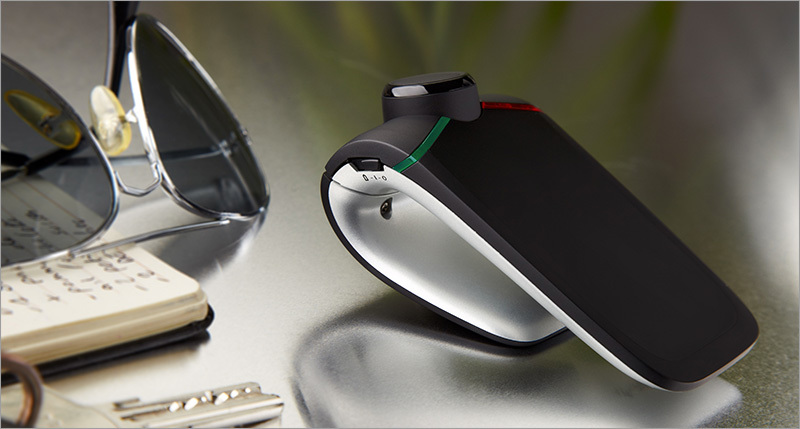
Our previous reviews:
» Testing AA-size Ni-MH batteries
» Sony Smartwatch 3
» LG G Watch
» Transformer Lenovo Yoga 2 Pro
» LEGO Mindstorms EV3

If your car is not equipped with a handsfree system, then such a device will add +1 to your safety while driving - I think this is much more necessary thing than, for example, a wireless speaker with the same principle of operation.
Equipment
The device is sold in traditional (for Jabra products) black and yellow packaging. The device itself is located in the upper part of the package (you can easily get it, for example, for checking in the store), and all the other parts are under it.
')

The package is modest - in addition to the adapter-plug for power supply from the car network (12-24V at the input, 5V and 750mA at the output) with a USB connector:


... there is only a meter-long USB-microUSB wire (for charging the device) and instructions in several languages (including Russian):

On the one hand, the set has everything for “sat down and went,” on the other hand, I wanted to see at least a rag cover - surely many people will sometimes remove the device in the glove compartment.
Appearance
The device is quite large (104x56x18mm with a weight of 100g), it is pleasant in the hand, but its form makes it unambiguously clear that the manufacturer implies a “hook” fastening. Well, since this Jabra is called Drive, then it is meant to be mounted in the car, namely, on the sun visor. However, nothing interferes with fastening it somewhere on the desktop or on a backpack during a hike - anything can happen.


The mount itself is a bent sheet of metal on which the speaker is mounted with the rest of the electronics. The design is universal (there is a margin for deformation - in case you have a lot of pieces of paper under the visor) and reliable - it should not break from assembly / disassembly. From the street, the device is completely unnoticed.

The main part of the functional side is occupied by the speaker, which is located behind the black (there is a white version) cover-grid. At first it seemed to me that a giant gap was conveniently located between the speaker and the mount, but it turned out that this was the place for the button to move - the fact is that the speaker is also a button at the same time (for example, receiving a call). It also has a status LED in the form of a tube, which is lit in different colors depending on the mode of operation. It's great - with such dimensions it is difficult to miss even at speed.

Just above is a microphone and rocker for volume control, also quite large. Their main drawback is that to adjust the volume you need not to hold, and repeatedly press - on the road this is not the most convenient scenario. But this is not a problem - most likely you will once set the volume level that is convenient for you and forget about these buttons (well, or you will make it louder / quieter once a month.

Another button (to turn on the device) is located on the side - it does not accidentally touch it. From the connectors - only microUSB for recharging the built-in battery.

I can’t say that I’m straight from the look of this device, but at the same time there’s nothing in it that I don’t like; workmanship and assembly at a high level.
A question for connoisseurs: why two holes on the device mount? Smiled when I found the answer.

Work with the device
When first turned on, the device will automatically suggest pairing with the phone - the pairing algorithm is no different from other bluetooth devices. NFC is not here, so the speakerphone won't be able to pick up the speakerphone, and the model was developed back in 2011, when they didn't even really talk about NFC. But it is worth paying tribute that after almost 4 years, the model remains relevant and competitive.
Talking on the “gill” is not inferior (except for the loudness of the speakers) to a conversation with the HandsFree built into the car: the sound is clear and clear, although, as I said, the volume margin is too small. The microphone is very sensitive, has a built-in echo and noise reduction, which reduce the flow of "garbage" in the ears of the interlocutor. In some cases, the interlocutor does not guess at all that the conversation is conducted through a speakerphone.
Accept a call - pressing the main key once, rejecting a call - double pressing the same button. Pressing the button twice in normal mode will dial the last number. There is also a mute during a call (you need to hold down the volume key for 2-3 seconds) - this is where the list of device capabilities ends. There is not enough voice response function - you have to manually pick up the phone all the time.
Oddly enough, the device is not deprived of the A2DP stereo protocol with the ability to transfer music via bluetoth, and EDR support is in place. Again, it all comes down to a small speaker volume - enough to listen to podcasts, but not to get high from the music.
Able to "column" to work with two phones at once, but the bundle algorithm is somewhat tricky. First, you need to bind one phone. Then, turning off Bluetooth on it, using a similar algorithm, pick up a second phone to the speakerphone. Then reattach the first. However, the feature works, calls and notifications can be received from both devices.
As for battery life, the manufacturer claims 30 days in standby mode and up to 20 hours in talk mode. But during the test I couldn’t put the battery in - I don’t talk for 20 hours :) The time for the device to fully charge the battery is 2.5 hours (via the adapter from the kit).
The only found and significant drawback in Jabra Drive is that the device “falls asleep” after 30 minutes of inactivity, after which it has to be “woken up” by the power switch every time. The rest of the device works without any problems. And the most important thing in it is completely “automotive” ergonomics: large buttons with a good stroke, which are conveniently pressed blindly, without looking away from the road. I believe that the manufacturer coped well with the task of creating a car speakerphone.
Advantages and disadvantages
+ Appearance
+ Noise and echo cancellation
+ Universal mount, almost imperceptibly in the cabin
+ Intuitive operation
+ Built-in battery
- Not enough functions
- Insufficiently high volume
- The need to "wake up" the device after it is "falling asleep"
- Price
At the time of publication of the article the cost of Jabra Drive in the store Yulmart is 3990 rubles. We agree that it is a little expensive for a sheet of metal with a speaker and a Buetooth module, but it was literally in the summer that you could buy this device for 2000 rubles.
Instead of output
If your car is not equipped with a handsfree system and you are looking for a replacement, you can pay attention to the Jabra Drive - a very simple speakerphone that is convenient to use on the road.
If you want something more from the speakerphone, you may like the Parrot MINIKit Neo , which at a similar price can do much more (for example, maintains an address book, pronounces the names of interlocutors when calling, has a mobile application, and so on).

Our previous reviews:
» Testing AA-size Ni-MH batteries
» Sony Smartwatch 3
» LG G Watch
» Transformer Lenovo Yoga 2 Pro
» LEGO Mindstorms EV3
Source: https://habr.com/ru/post/375729/
All Articles